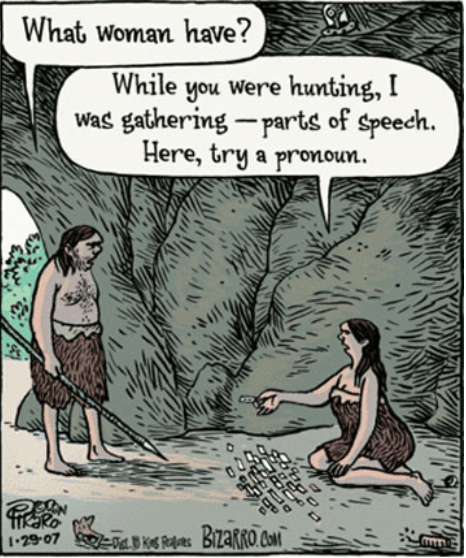Pronouns: Lesson Plans and Teaching Resources
Are You My Mother?
Students use P. D. Eastman's book to search for pronouns and antecedents. Follow the tab for downloadable charts and worksheets. Designed for grades K-2.
Avoiding Sexist Language by Using Gender-Fair Pronouns
This lesson plan engages students in a brief writing assignment that concretely illustrates how language and gender stereotyping interact causally. Students write a response to a short prompt which includes no information about the participants' gender. Once the writing is complete, students and teacher analyze the narratives for the use of pronouns and what the pronoun choices reveal about language use. This lesson requires 2 50-minute periods and is designed for high school.
Chalking Points: Me versus Myself
This downloadable YouTube video (3:22) explains when to use the objective and when to use the reflexive forms. Very engaging; will work with upper elementary through college. Includes advertising at the end.
Chalking Points:
That
vs.
Which
This downloadable YouTube video (4:20) explains how to use these relative pronouns with restrictive and nonrestrictive clauses. Includes advertising at the very end.
Demonstrative Adjectives and Demonstrative Pronouns
Explanation and a great infographic for your classroom.
Pop Pronouns
This review activity asks students to identify the pronouns in a piece of popular music. It is designed for grades 6-8.
Pretests
Pretests and answer keys for identifying nouns, pronouns, and verbs.
Pronoun Hunt
In this activity students find the pronouns in a newspaper article. It is designed for grades 3-5.
Reflexive Pronouns
Explanation, practice sentences, and answer key.
Reflexive Pronouns: All You Need to Know
Explanation and a downloadable poster.
Schoolhouse Rock: "Rufus Xavier Sarsaparilla"
This Grammar Rock video is a good introduction. It runs 3:00.
Scrutinizing Stand-Ins: Working With Nouns and Pronouns
Students identify the connection between nouns and pronouns and discuss how the clarity of a sentence is affected by using a noun as opposed to a pronoun. This lesson is from the New York Times and includes a link to an article (informational text) and discussion/analysis questions. Depending on the article selected, this approach can work with anyone old enough to study pronouns.
Substitute pronouns for nouns
Students replace nouns with pronouns. Follow the tab for downloadable worksheets. Designed for grades K-2.
Vague Pronouns
Students read and analyze a mentor text (an excerpt from Roald Dahl's "Boy: Tales of Childhood," included), write their own narrative vignette, and analyze their use of pronouns. Designed for high school.
Who
or
whom
?
Explanation and downloadable poster.

